Back to The Peregrine's Saga main page
A TIME-LINE
CONCERNING THE WRITING OF
THE PEREGRINE’S SAGA
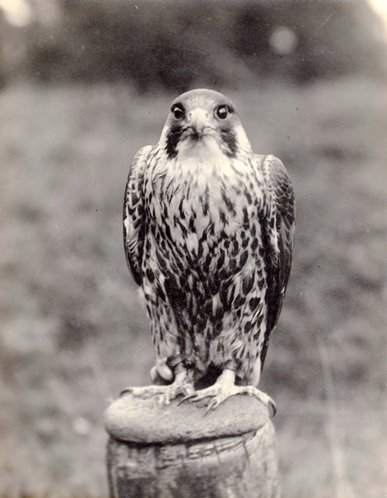
That HW was fascinated by peregrine falcons is obvious by his various writing on the subject. The purpose of this time-line is to clarify the sequence of articles and their inclusion in various early writings that culminated in the set of stories known as The Peregrine’s Saga, the final version of them being contained within The Henry Williamson Animal Saga (1960).
Known articles regarding peregrine falcons in chronological order
The Weekly Dispatch, 12 September 1920:
‘Falcon’s Raid on London: Pigeon Victim over St. Paul’s’
And two attendant articles:
Evening News (undated):
‘Crowd at St. Paul’s to see the Falcon’ (becomes ‘The Outlaw’ in The Lone Swallows, first edition 1922; transmuted into ‘Chakchek’s Raid on London’ in The Old Stag, 1926)
The Observer, 2 October 1920:
‘Peregrine Falcons in London’
The Field, 16 July 1921:
‘Peregrines in Love’ (in The Lone Swallows, first edition 1922)
Pictorial Review (USA), 1922:
‘A story of Peregrine Falcons’ (The only information on this comes from The Sun in the Sands (1945), p. 144: 'One morning the postman brought me a letter from my literary agent telling me that he had sold the story of the peregrine falcons to the Pictorial Review in America for five hundred dollars, and he enclosed a cheque for ninety-eight pounds.' This is almost certainly 'Peregrines in Love'.)
Hutchinson’s Magazine
April 1923: ‘The Saga of Chakcheck’ (in The Peregrine’s Saga, first edition 1922)
May 1923: ‘Wizzle, Son of Chakchek’ (see later information)
Pan Fiction, November 1923:
‘The Revenge of the Chakcheks’
TP’s Weekly, 14 June 1924:
'The Falcon’s Fighting Tactics’
The Adelphi, September 1924:
‘The Doom of the Peregrine Falcon’ (reproduced below; collected in Words on the West Wind, ed. John Gregory, HWS 2000)
Colliers Weekly (USA), 11 April 1925:
‘No Eel for Nog’ (In The Old Stag, 1926)
Hutchinson’s Magazine, September 1925:
‘No Eel for Nog’ (In The Old Stag, 1926)
Harpers Monthly, December 1932:
‘The Backbreaker’s Bride’ (in The Peregrine’s Saga, 1934 edition)
Windsor Magazine, June 1933:
‘The Backbreaker’s Bride’ (in The Peregrine’s Saga, 1934 edition)
John o’London’s Weekly (in its supplement ‘Outline), 22 December 1934 (reproduced below):
‘Peregrines over the Estuary’
Argosy
March 1936: ‘No Eel for Nog’ (in The Old Stag, 1926)
October 1936: ‘The Vigil of Mousing KeeKee’
Evening Standard, 17 May 1937 (reproduced below):
‘The Flight of the Falcons’
Evening Chronicle, 24 May 1937:
‘The Flight of the Falcons’
Daily Express, 30 November 1968 (reproduced below):
‘The noble hunter is back in town’ (Collected in Days of Wonder, ed. John Gregory, HWS 1987)
This list may not be complete. Any further information would be very welcome.
*************************
|
PEREGRINE FALCON FACTS
(Falco peregrinus)
The FEMALE: is the ‘falcon’
body length: c. 22 inches wingspan: c. 29 inches
The MALE is called the ‘tiercel’ (one third smaller)
body length: c. 15 inches wingspan: c. 23 inches
NEST: large – a basic scrape with twigs on cliff or high precipice (occasionally on ground – especially in the Arctic) Usually 4 eggs – reddish-brown in colour
Can live up to 17 years in the wild
|
*************************
The earliest writings
The Weekly Dispatch, 12 September 1920:
(Collected in Contributions to The Weekly Dispatch (July, 1920–January, 1921), ed. John Gregory, privately published 1969; reprinted by HWS 1983)
Falcon’s Raid on London: Pigeon Victim over St. Paul’s
A peregrine falcon – an unusual sight in London – visited the neighbourhood of St. Paul’s Cathedral yesterday afternoon and caused one death and general consternation among the pigeons.
About 50 of these half-tame pigeons were wheeling around the dome when the Falcon arrived, closed its wings, and swooped down at about 150 miles per hour.
The pigeons dived to cover. A burst of feathers fluttered and danced in the air: one pigeon had been struck and was being carried off.
The peregrine falcon, the corsair of the air, is extremely rare. It usually haunts high and desolate cliffs on lonely parts of the coast. A hundred years ago, however, it used to haunt the region of St. Paul’s.
The following two related articles are pasted into the large folio journal that HW kept in the 1920s (known as his ‘Richard Jefferies Journal’).:
Evening News (undated):
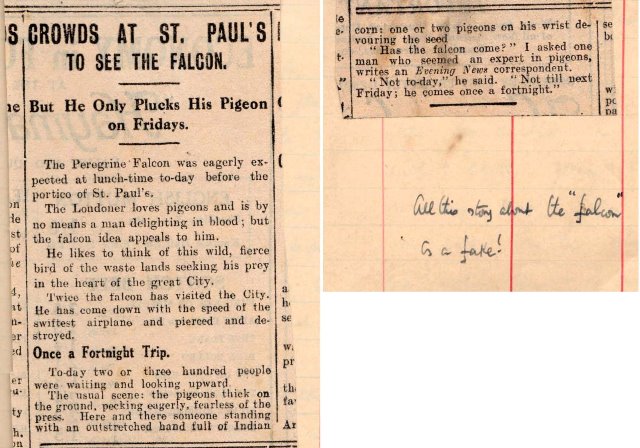
The Observer, 2 October 1920:
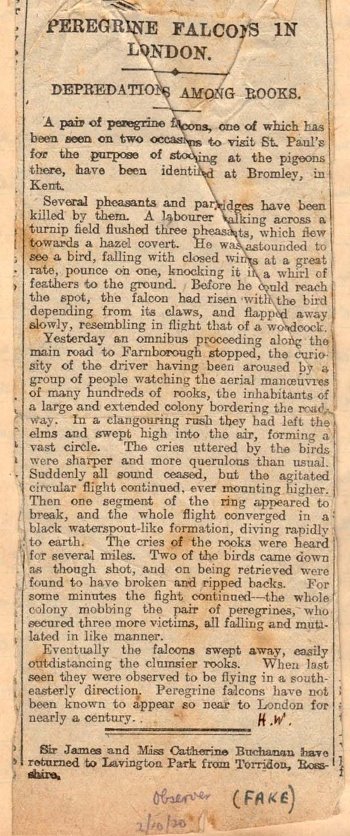
Although HW noted here that these stories were ‘fakes’, elsewhere he has noted that that statement itself was untrue. So it is difficult to know either way! In his ‘Introduction’ to The Henry Williamson Animal Saga (1960) – see later – he certainly mentions the story as a fact. As peregrines currently regularly use cathedrals as nesting sites all over the UK it is quite possible that the story is actually true.
The Adelphi, September 1924:
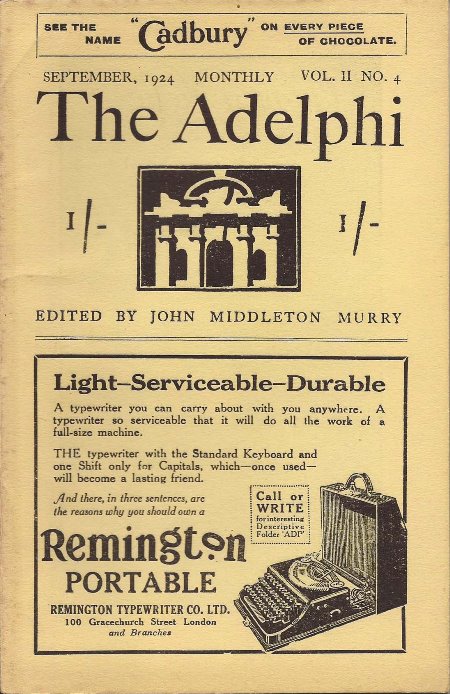
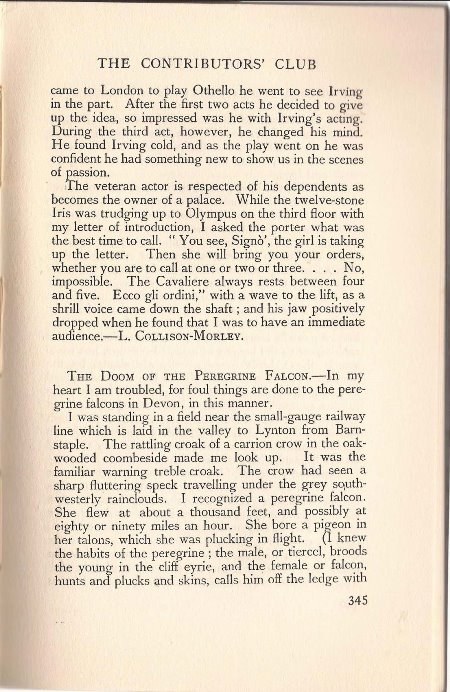
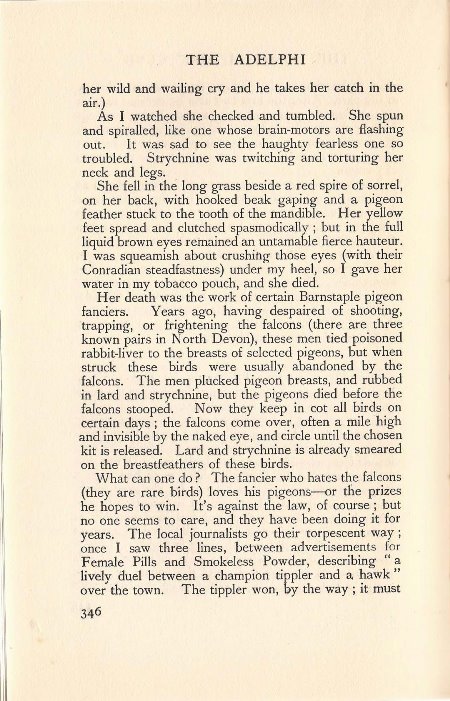
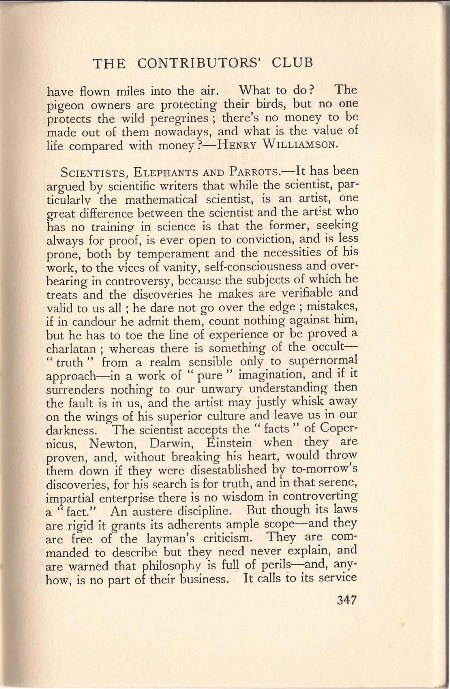
*************************
How the articles appeared in various books
HW made various revisions to his stories with each succeeding version. I have not attempted to tabulate these here.
The Lone Swallows (Collins, 1922)
There are two peregrine stories in this first compendium.
‘The Outlaw’ (pp 116–129), ‘Being the indisputable (journalese) truth about the peregrine falcon that came to St. Paul’s Cathedral in 1920.'
Well into the story we read:
The journalist, who worked with a newspaper that went to press on Saturday night for publication on Sunday, was passing St. Paul’s Cathedral. He stopped to look at the pigeons strutting and searching for crumbs upon the worn paving stones. . . .
Looking up to the dome he saw a flock of about fifty pigeons wheeling in steady flight near the cross at the top. A speck fell with a suddenness that reminded him of a shot aeroplane: like a plunging halbert-head it was; there was a puff of feathers, dancing and fluttering – the flock scattered, dived to earth, anywhere, anyhow, and the dark halbert-head became outlined against the sky, perched on the gilt cross that glittered in the afternoon sun.
So – this story is worked up from those early 1920 articles pasted into his ‘Richard Jefferies Journal’, where he marks them as ‘fake’– but elsewhere refutes that statement!
‘Peregrines in Love’ (pp 130–135). The story is dedicated ‘To E.G.S.’ [Esther Graham Stokes, the mother of Mary Stokes (‘Annabelle’ in The Sun in the Sands).]
In the salt winds of the Atlantic, and above their ancient eyrie, the peregrine falcons anchor their flight with easy mastery of the gusty upturns of the precipitous headland face. . . .
The eyrie is a hundred feet down the cliff-face, upon a narrow ledge [this is Bone Ledge] . . .
And so on – until the end:
On the falcons rush, above the crested waves and the marbled troughs of the ocean, past the crannies and the ledges of the precipice, among the summer cloudlets, over the hills of heather and the slopes of golden gorse, by the mounded sand-dunes and the glistening mud-flats; all the heavenly freeness is theirs to roam. . . .
This story was first printed in The Field, 16 July 1921.
The Peregrine’s Saga (Collins, November 1923)
There are only two actual peregrine stories in this volume. The first opens the book:
‘The Saga of Chakchek the One-Eyed’ (pp 1–19)
. . . head of the ancient and noble house of Chakchek, haughtiest falcons in the West Country; The One-Eyed, who ranged the airways above Exmoor and the Bristol Channel; who fled at will above the seaboard of Devon, Somerset, and Cornwall; who raced over to Lundy Island because he fancied the blood of a sea-parrot; Chakchek the unmated, Chakchek the outlaw. Hark to the Saga of Chakchek the One-Eyed!
Chakchek had been born on Bone Ledge two years before, and we read of his first mating. From this mating ‘out of a red-brown shell’ hatches Wizzle and his sister. But the parents, Chakchek and his mate, come up against the unpleasant and cruel pigeon-fancier Sir Godfrey Crawdelhook, who, by lacing poison on to a captured pigeon, kills first the falcon, and then when Chakchek, realising something is wrong, flies down to her, the tiercel as well. The description of their deaths is explicit and gruesome.
[Chakchek] flew up into the sky. Higher and higher he winged, while the lark-song died and the sounds below became murmurous and then silent – even the far wash of the sea that he loved so well. Perhaps he flew upwards because in his pain some dim instinct told him that he would find his mate in the solitudes of heaven, near the life-giving sun, even beyond, where it was very quiet and peaceful. . . .
He falls onto Saunton Burrows:
Whilom the proudest of all living creatures, swiftest over the airways of the north Devon and Cornwall sea-board, tenderest lover and kindest father – thus died Chakchek the Blind.
This story first appeared in Hutchinson’s Magazine, April 1923. It is in the 1934 illustrated edition of The Peregrine’s Saga as the fourth story of ‘The Peregrine’s Saga’ with a new title – ‘Love and Death of the One-eyed’ – and correspondingly forms Part 4 of ‘Chakchek the Peregrine' in The Henry Williamson Animal Saga (Macdonald, 1960).
The second story ends the book:
‘The Saga of Mousing KeeKee’ (pp. 277–301)
Far away over the western sea a star flickered, like a gold falcon flying in the dark. Perhaps it was the god of all the hawks, giving rest to the spirits broken from feathered bodies by men with shot, gin, and poisoned lure. Wizzle of the Chakcheks saw it . . .
Wizzle and his sister are the offspring of Chakchek, killed at end of the first story – leaving the chicks abandoned on Bone Ledge, Baggy Head, which in due course are fostered by Mousing KeeKee, a kestrel.
The star hung over Lundy, midway between the two lighthouses. The flickering gold of its flashes seemed to tremble and beat like the wings of a faithful guardian watching in the night. . . .
This story becomes the fifth story, as ‘The Vigil of Mousing KeeKee’, in 1934 illustrated edition of The Peregrine’s Saga, and Part 5 of ‘Chakchek the Peregrine’ in The Henry Williamson Animal Saga. It was first published as ‘Wizzle, Son of Chakchek’ in Hutchinson’s Magazine, May 1923.
Note distinct nuances of thought in both stories that connect to HW’s later novel, The Gold Falcon (Faber 1933).
The Old Stag (Putnam, October 1926)
The peregrine falcon stories that appear in this volume are:
‘No Eel for Nog’ (pp. 32–99)
It tells the tale of the harassment of the heron, Old Nog, desperately trying to find food for his voraciously vocal youngsters as his mate has been killed by a peregrine. He manages to catch, despite being harried by various other creatures, a rainbow trout, a frog, a rat, a beetle, and a duckling – all swallowed and stored. Then he espies an eel, but has to battle with Oylegrin the shag, but who suddenly gives up because:
Half a mile above him, steady on pitches in the wind, three birds, sharp in outline like specks of slate, were watching, and – in an ancient term of falconry – were waiting on.
They were peregrine falcons of the ancient and noble house of Chakchek.
The peregrines think they should have the eel and the ensuing ‘tug-of-war’ is described over four pages: Old Nog finally manages to dive into the river and so eludes his attackers. He arrives back at the heronry, exhausted but triumphant that his cache of food is still inside him – only to have to heave up the contents of his stomach to feed his voracious and demanding young.
This story had first appeared in Hutchinson’s Magazine September 1925, and also in Collier’s (USA) in May 1925. It is printed as the second story, ‘No Eel for Nog’, in the 1934 illustrated edition of The Peregrine’s Saga, and as ‘Part 2’ in The Henry Williamson Animal Saga.
.
‘Chakchek’s Raid on London’ (pp. 181–194)
A further reworking of the original peregrine stories that HW wrote in 1920 during his few months working as a journalist, and which had appeared under the title ‘The Outlaw’ in the first edition of The Lone Swallows.
Here it opens with a superb description of Nelson’s Column in Trafalgar Square, over which is circling a peregrine falcon. There are many pigeons in Trafalgar Square, fed by a woman who places corn on the ‘dinted bowler hat’ of the newsvendor. The date is ’September of Nineteen Fourteen’ – and the newsvendor is announcing (with heavy irony on the part of our author!) ‘the British Army’s Great Victory’.
We read, that, having escaped from his master in Devon, the peregrine:
. . . flew with quick flutterings of pointed wings, followed by short level glides. His scaly yellow legs, with their four toes and black sickle-claws, were pressed into the brown plumage of his body. His beak was blue and pointed. He had black patches on his cheeks. His eyes showed him to be noble . . . He was Wizzle, son of the One-Eyed.
He moves on to St Paul’s Cathedral, where he stays for two days harrying the pigeons. Moving on to Hyde Park, Wizzle is seen,
to the excitement of a falcon-eyed, white-bearded man who had been watching it through glasses; for the old gentleman had been observing birds in Hyde Park for many years, and he knew that the peregrine falcon was a rare visitor.
A footnote tells us ‘The old gentleman bore a resemblance to the late W.H. Hudson.’ (Hudson died in 1922 – HW’s note was in retrospect).
After various adventures Wizzle departs with the migrating swallows, eventually returning to Devon:
For he was a peregrine, which means wanderer.
The Village Book (Cape, 1930)
There are two peregrine stories in this volume. The first comes under the overall section ‘First Day of Spring (3)’ (also in the later volume Life in a Devon Village).
‘The Peregrine Falcons’ (pp 186–189)
The author is lying ‘on the lip of the precipice' (of Baggy Point),
breathing in the wild thyme of the sward. While I lay there in the sun two peregrines flew swiftly over the cliffs, stooping upon each other in play. . . .
The stoop, or dive, of the falcon is magnificent. He shuts his wings and dives head first at so steep an angle that it appears to be a perpendicular drop. It is not a swooping down, but a drop of a bundle of sinew, muscle, bone, and feathers compressed between the barb of wings, directed by fearless power concentrated in one terrible thing – the intentness of the eyes. . . .
After their play the falcons rose on the wind until they were six hundred feet above me, ‘waiting on their pitches’ in the term of falconry. They remained still in the wind. The wings were bent back, sharp and dark, the head blunt, the tail thick, short and stocky.
A pipit appears, struggling with the wind. The peregrines attack to the dread of the watcher, but both miss and then leave it alone and it lands exhausted near the watcher. It is a charming fragment of observation on an idyllic spring day.
‘Flight of the Falcon’ (pp 270–-272)
The story opens in the same words as the first:
I am lying on the sward at the lip of the precipice, three hundred feet above the Atlantic. A strong north-west wind is blowing, making broad streaks on the sea.
His friend is below exploring Baggy Hole; he shouts,
and immediately a bird with dark blue pointed wings shoots out a hundred feet below me, sweeps up into the wind without a tremor, and cuts a wide circle over the sea and the rocks. It glides level with my eyes. As it glides, straight it seems into my glasses, I see that the wings are slightly downheld, but each wing is straight. . . .
The wings flicker nervously, they cease, and she glides a hundred yards; flicker again, for ten beats, then gliding fifty yards, she cries in a harsh, shrill chatter, aik-aik-aik!
The tiercel arrives:
He cuts through the air three hundred feet over my head, suddenly tipping sideways and falling with half-closed wings. As always the speed of his stoop excites and amazes me. Then the grand swoop up again, shooting upwards fifty feet in less than a second. . . .
The tiercel glides past his mate, and down a slight incline, faster and faster, never a wingbeat, reaching the headland's point, a thousand feet away, in about ten seconds, swooping up again . . . then turning into the wind and rising to the size of a small star.
Their young are about to hatch out of ‘three rusty-red eggs’ which reminds the author of his own babe asleep in his cot (so the year is 1925), and he whistles up his spaniel to return home.
(Matthews, in his Henry Williamson: A Bibliography, states this was printed in the Evening Standard, 17 May 1937, and the Evening Chronicle, 24 May 1937.)
*************************
The Final Versions
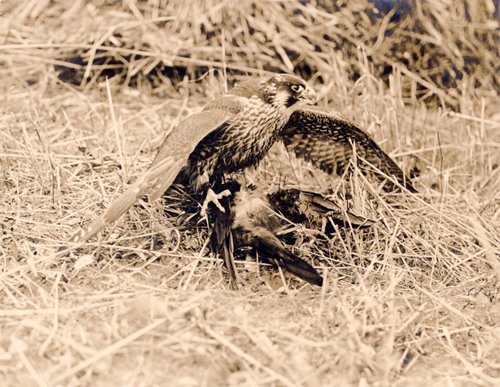
This photograph has a note written by HW on the reverse:
Young peregrine, immature plumage . . . Return to HW
It was filed with two other photos dated 1932 (including the one that heads this page), and they were almost certainly sent to C. F. Tunnicliffe to help him with the illustrations for the new edition of The Peregrine's Saga, as at that point 'Tunny' had never seen a peregrine.
The Peregrine’s Saga (Putnam, 1934, with woodcuts by Charles F. Tunnicliffe):
The final version consists of five stories now gathered together under the section title of ‘The Peregrine’s Saga’ (pp 176–265):
‘The Backbreaker’s Bride’ (from Harper’s, December 1932, and Windsor, June 1933)
‘No Eel for Nog’ (from Hutchinson’s, 1925, and The Old Stag, 1926)
‘The Raid on London’ (from the original 1920 short items / ‘The Outlaw’ in The Lone Swallows, 1922, and ‘Chakchek’s Raid on London’ in The Old Stag,1926)
‘Love and Death of the One-Eyed’ (is ‘The Saga of Chakchek the One-eyed’ from The Peregrine’s Saga, 1st edition, 1923)
‘The Vigil of Mousing KeeKee’ (is ‘The Saga of Mousing KeeKee’ from The Peregrine’s Saga, 1st edition, 1923)
The Henry Williamson Animal Saga (Macdonald, 1960):
The contents of this omnibus volume include Tarka the Otter, Salar the Salmon, The Epic of Brock the Badger, and the five definitive peregrine stories from The Peregrine’s Saga 1934 edition. However Matthews notes that there are slight changes in all the texts.
In his Foreword HW, in a significant statement, writes that these items represent:
The four chief epics of the natural world of the first half of my life . . . for which four special pieces have been written [HW is here referring to his section ‘Introductions’] whereby the reader is led into the author’s realm of river, sea, earth and air.
The peregrine stories are printed as the last section of this volume, under the title ‘Chakchek the Peregrine’ (pp 421–477), but without the titles given in The Peregrine’s Saga 1934 edition, the stories being just numbered 1 to 5.
In his ‘Introduction’ to this section we find reference to the facts that were to form the basis of his last book The Scandaroon:
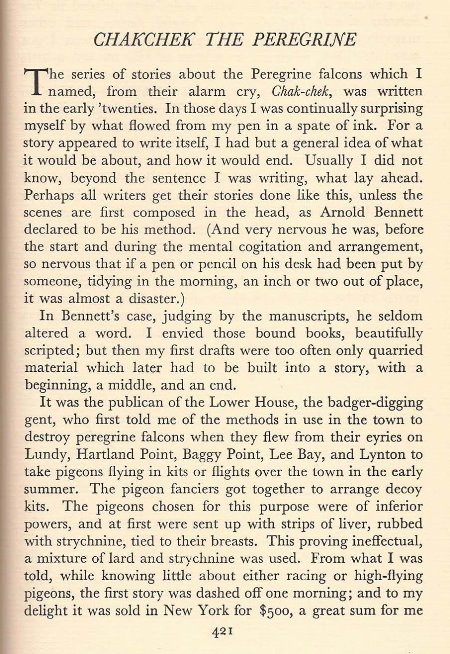
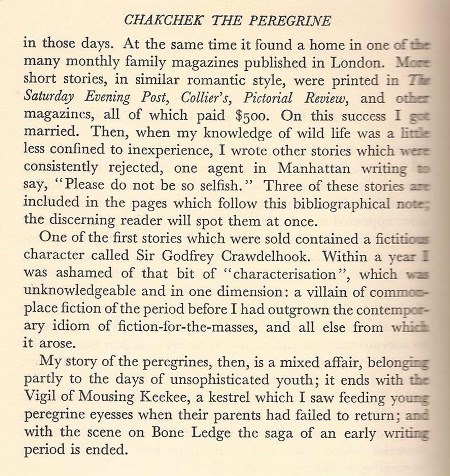
*************************
Some later articles
John O’London’s Weekly, 22 December 1934 (The illustration is from The Peregrine Falcon at the Eyrie, Francis Heatherley 1913, HW's copy of this book being inscribed by him '1922'):
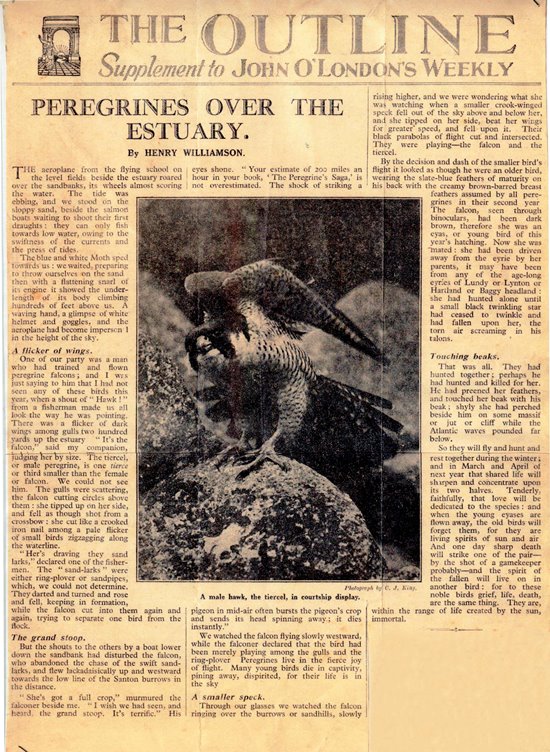
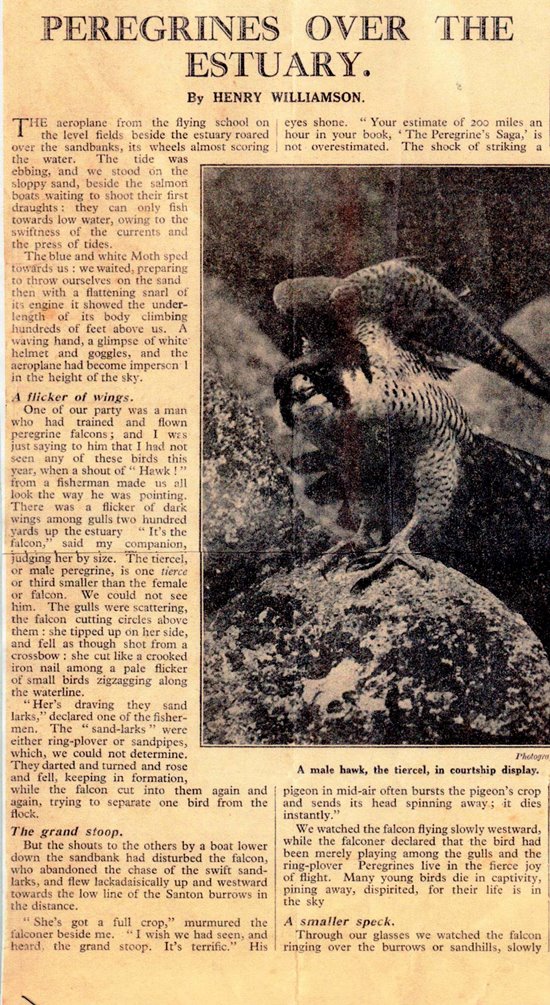
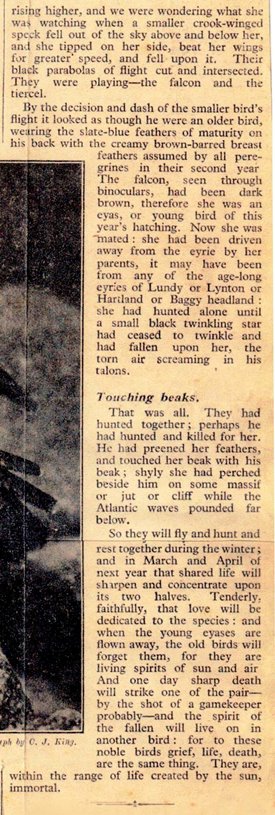
Evening Standard, 17 May 1937:
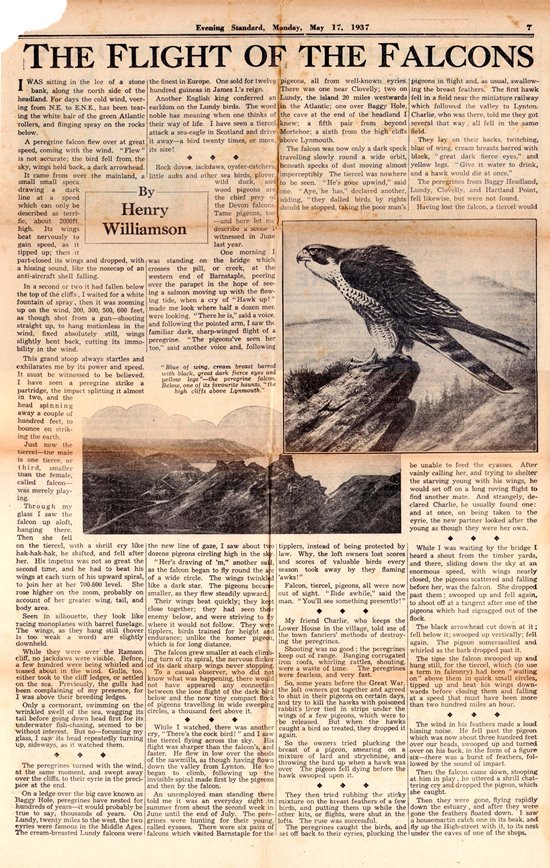


Daily Express, 30 November 1968:
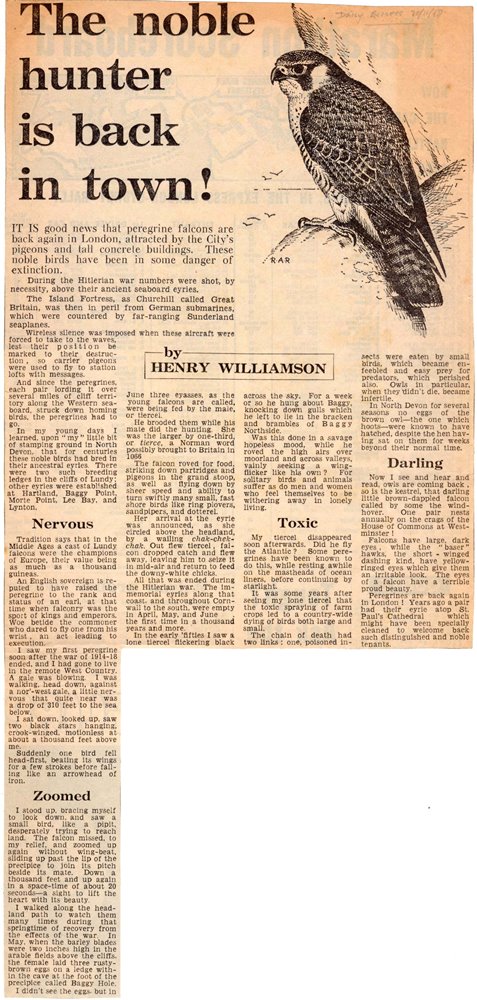

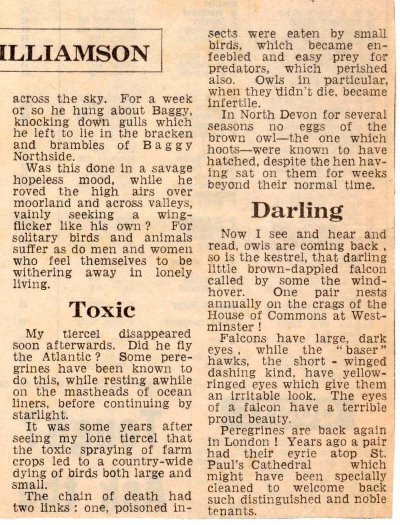
This article was part of a short series illustrated by Richard Richardson, a renowned ornithologist whom HW first met in the Norfolk Farm era. It is reprinted in Days of Wonder, ed. John Gregory (HWS, 1987, e-book 2013).
*************************
Back to The Peregrine's Saga main page
